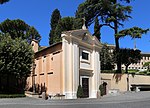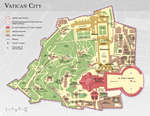Gardens of Vatican City

The Gardens of Vatican City (Latin: Horti Civitatis Vaticanae), also informally known as the Vatican Gardens (Italian: Giardini Vaticani) in Vatican City, are private urban gardens and parks which cover more than half of the country, located in the west of the territory and owned by the Pope. There are some buildings, such as Vatican Radio and the Governor's Palace, within the gardens. The gardens cover approximately 23 hectares (57 acres), about half of the city. The highest point is 60 metres (197 ft) above mean sea level. Stone walls bound the area in the North, South, and West. The gardens and parks were established during the Renaissance and Baroque era and are decorated with fountains and sculptures. Pope Francis opened the Vatican Gardens to the public in 2014. Individuals and pre-formed groups, considered to consist of sixteen or more people, may visit the Gardens with the presence of a tour guide. The gardens also enshrine eighteen Marian images venerated worldwide at the designation of the Pope, who is the owner of the gardens.
Excerpt from the Wikipedia article Gardens of Vatican City (License: CC BY-SA 3.0, Authors, Images).Gardens of Vatican City
Governorat's Square,
Geographical coordinates (GPS) Address Nearby Places Show on map
Geographical coordinates (GPS)
| Latitude | Longitude |
|---|---|
| N 41.903055555556 ° | E 12.450555555556 ° |
Address
Giardino Roccioso
Governorat's Square
00120 , Vatican City
Vatican City
Open on Google Maps








